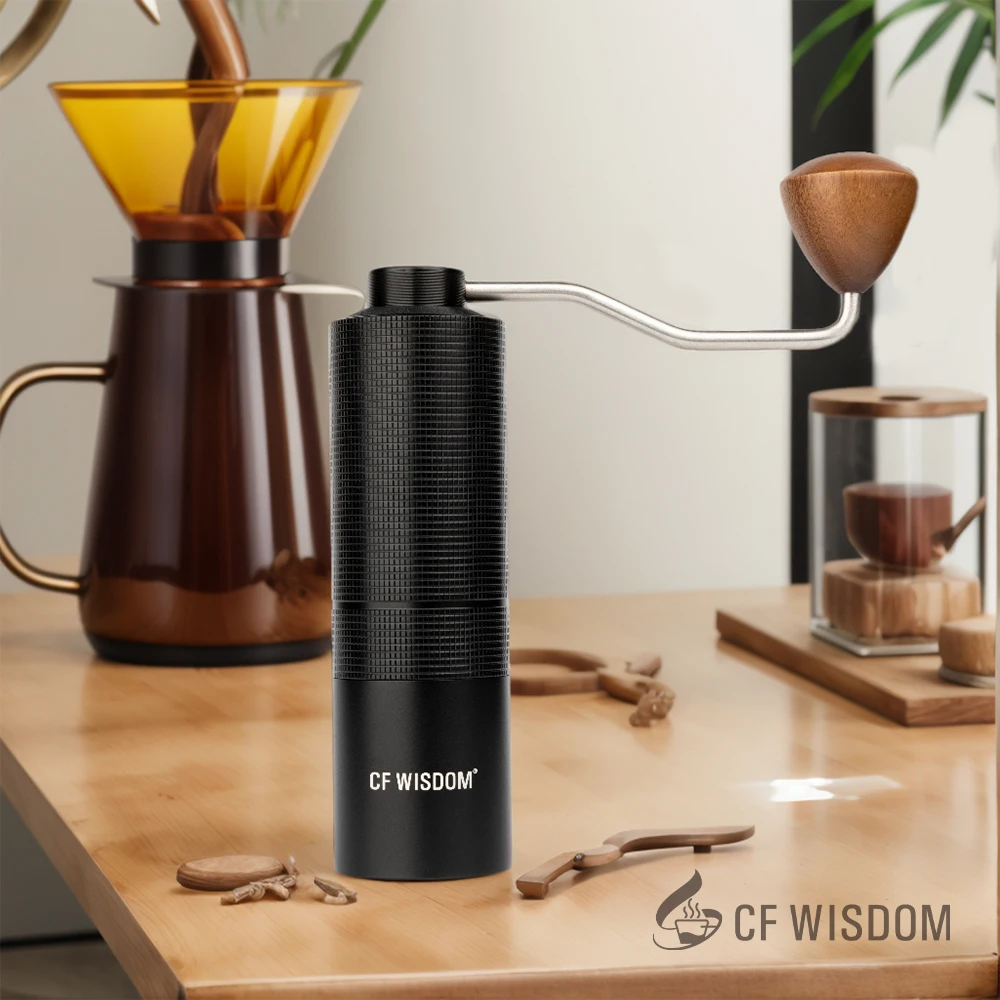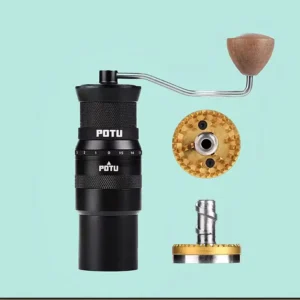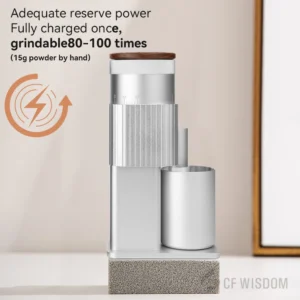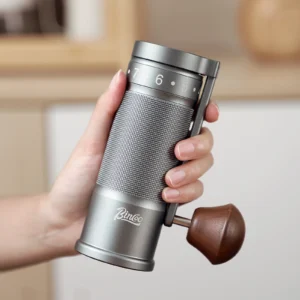Understanding Coffee Grinder Basics: The Foundation of Great Coffee
The journey to an exceptional cup of coffee begins long before hot water touches your grounds. In fact, one of the most crucial steps happens during the grinding process. The way your coffee beans are ground fundamentally affects extraction, flavor development, and overall brewing quality.
Most coffee enthusiasts recognize two primary types of grinders: burr grinders and “regular” grinders (which are commonly known as blade grinders). While they may serve the same basic purpose, the differences between these two types are significant and directly impact what ends up in your cup.
Understanding the distinction between these grinder types isn’t just coffee snobbery—it’s backed by science. Research consistently shows that particle size distribution dramatically affects extraction rates, with uniform particles extracting evenly while inconsistent grounds create imbalanced flavors.
Key takeaways:
– Grinding is one of the most critical variables in coffee preparation
– The type of grinder you use directly impacts extraction quality
– Professional baristas overwhelmingly prefer one type for a reason
– Your choice of grinder affects every brewing method you’ll use
The comparison between burr and blade grinders reveals why many coffee enthusiasts consider the grinder to be the most important piece of equipment in their coffee setup—even more important than the brewing device itself.
What is a Regular (Blade) Grinder?
When most people think of a coffee grinder, particularly those new to home coffee brewing, they envision a “regular” grinder—technically known as a blade grinder. These compact devices feature a simple design with a small chamber containing sharp, propeller-like blades that spin at high speeds (typically 20,000-30,000 RPM) to chop coffee beans into smaller pieces.
Operation couldn’t be simpler: you add beans to the chamber, press a button, and the blade spins until you release it. The longer you hold the button, the finer the coffee becomes—at least in theory. These devices are remarkably similar to standard food processors or spice grinders in both mechanism and operation.
Blade grinders are widely available at most home goods stores and online retailers, typically priced between $15-40, making them an attractive option for coffee drinkers on a budget. Their small footprint also makes them convenient for kitchens with limited counter space.
However, the simplicity that makes blade grinders accessible also creates fundamental limitations. The spinning blade doesn’t actually “grind” coffee—it chops and smashes the beans randomly. This creates a significant issue that we’ll explore further: inconsistency in particle size.
The basic coffee grinders comparing burr versus blade mechanisms reveals important differences that directly impact your brewing results, regardless of which brewing method you prefer.
How a Burr Grinder Works: The Precision Alternative
Burr grinders operate using a fundamentally different mechanism than blade grinders. Instead of chopping beans with a high-speed blade, burr grinders crush beans between two abrasive surfaces called burrs. One burr remains stationary while the other rotates, creating a precise crushing action that mills beans to a consistent size.
The design allows beans to enter from a hopper above, pass through the burrs where they’re ground to a specific size, and then exit into a collection chamber. What makes burr grinders special is the ability to adjust the distance between the burrs, which precisely controls the resulting grind size.
There are two main types of burr configurations:
– Conical burrs: Feature a cone-shaped inner burr that fits inside a larger outer burr, creating a more gentle grinding action
– Flat burrs: Consist of two parallel rings with teeth that face each other, typically found in higher-end models
Burr grinders also typically operate at significantly lower speeds than blade grinders—often between 400-1000 RPM. This slower speed generates less heat during grinding, which helps preserve volatile compounds responsible for coffee flavor and aroma.
The material of the burrs themselves varies between models, with the comparison between ceramic and steel burrs showing distinct advantages depending on your specific needs. Our manual coffee burr grinders collection features various materials to suit different preferences.
The precision engineering behind burr grinders explains their higher price point but also explains why they’re considered essential equipment by coffee professionals worldwide.
Grind Consistency: The Fundamental Difference
The most critical difference between burr and blade grinders—and the one that influences every other aspect of comparison—is grind consistency. This single factor dramatically impacts how your coffee extracts and ultimately how it tastes.
Blade grinders produce notoriously inconsistent results. As the blade spins, it randomly hits beans, creating a mixture of particles ranging from fine powder to large chunks. This irregularity occurs because some beans get repeatedly hit by the blade while others bounce around the chamber avoiding repeated contact. Even with careful technique and “pulse grinding,” blade grinders simply cannot produce uniform results.

In stark contrast, burr grinders create remarkably consistent grounds. By design, coffee beans cannot pass through the burrs until they’ve been ground to the size determined by the burr spacing. This creates uniform particles that extract at the same rate during brewing.
When examined closely, grounds from a quality burr grinder show particle sizes that vary by fractions of a millimeter, while blade grinder results can vary by several millimeters—a massive difference in coffee extraction terms.
This consistency directly translates to extraction quality. When water contacts coffee grounds during brewing, it extracts different compounds at different rates. Smaller particles extract more quickly than larger ones. With inconsistent grinding, some particles over-extract (becoming bitter) while others under-extract (remaining sour or weak), creating an unbalanced cup.
Understanding why coffee grinders produce inconsistent results can help you address issues in your brewing process. Our precision manual grinders are specifically designed to address this fundamental challenge.
Impact on Coffee Flavor: How Your Grinder Affects Your Cup
The technical differences between grinder types directly translate to what matters most: the flavor in your cup. The consistency variance between burr and blade grinders creates distinctly different taste experiences.
When you brew coffee ground with a blade grinder, you’re essentially attempting to extract from multiple grind sizes simultaneously. The finest particles (coffee dust) over-extract almost immediately, releasing bitter compounds and astringent flavors. Meanwhile, the largest chunks under-extract, failing to contribute the sweet, balanced flavors that properly extracted coffee should have.
The result is a cup that often contains conflicting flavor profiles:
– Harsh bitterness from the over-extracted fine particles
– Sour, underdeveloped notes from under-extracted larger pieces
– Reduced sweetness and complexity overall
– Thinner body and mouthfeel
Additionally, blade grinders generate significant heat through friction, which can literally cook the volatile oils in your coffee beans before brewing even begins. These oils contain many of the delicate flavor compounds that give specialty coffee its distinctive character.
Burr grinders, by contrast, create the conditions for even extraction by providing uniform grounds. This consistency allows water to extract compounds from all particles at roughly the same rate, resulting in:
– Balanced sweetness and acidity
– Reduced bitterness and astringency
– More distinguishable flavor notes (fruity, chocolate, nutty, etc.)
– Fuller body and more satisfying mouthfeel
The pivotal role coffee grinders play in flavor extraction cannot be overstated. Professional baristas and coffee competition judges can immediately identify coffee ground with inconsistent equipment, demonstrating how dramatically grinding affects the final cup.
Adjustability and Brewing Methods: Getting the Perfect Grind Size
Different coffee brewing methods require specific grind sizes to achieve optimal extraction. The ability to consistently achieve these specific sizes represents another major advantage of burr grinders over blade models.
| Brewing Method | Ideal Grind Size | Burr Grinder Capability | Blade Grinder Capability |
|---|---|---|---|
| Espresso | Very fine | Excellent (with proper burrs) | Poor (inconsistent fineness) |
| AeroPress | Fine to medium | Excellent | Fair (requires sifting) |
| Pour-over | Medium | Excellent | Poor to fair |
| Drip coffee | Medium | Excellent | Fair |
| French press | Coarse | Excellent | Poor (too many fines) |
| Cold brew | Very coarse | Excellent | Poor (inconsistent) |
Burr grinders offer precise adjustability through various mechanisms:
– Stepped adjustment: Fixed positions that click into place between grind settings
– Stepless adjustment: Infinite adjustment points for ultimate precision
– Micro-adjustment: Fine-tuning capabilities especially valuable for espresso
This adjustability allows you to dial in the perfect extraction for each brewing method and even adjust for different coffee varieties, roast levels, and age of beans.
Blade grinders offer virtually no true adjustability. While you can vary grinding time to aim for generally finer or coarser results, you cannot reliably reproduce specific grind profiles or achieve true consistency at any setting.
This limitation becomes particularly problematic for brewing methods that are highly sensitive to grind size. The definitive guide to proper espresso grind texture demonstrates why burr grinders are essentially mandatory for quality espresso preparation.
Price Comparison: Value vs. Investment
One of the most obvious differences between burr and blade grinders is price, which represents the most significant barrier for many coffee drinkers considering an upgrade.
| Grinder Type | Price Range | Features/Quality |
|---|---|---|
| Blade Grinders | $15-40 | Basic operation, limited durability |
| Entry-Level Burr | $40-150 | Basic burrs, limited adjustability, plastic components |
| Mid-Range Burr | $150-500 | Better burrs, greater precision, metal components |
| High-End/Commercial | $500+ | Premium burrs, excellent consistency, durable construction |
Blade grinders are undeniably more accessible from a price perspective, making them appealing to casual coffee drinkers or those just beginning their coffee journey.
The price jump to even an entry-level burr grinder can seem substantial. However, many coffee enthusiasts consider this an investment rather than just an expense. Quality burr grinders typically offer:
- Significantly longer lifespan (often 5-10+ years with proper care)
- Consistent performance over time
- Better build quality and materials
- Improved coffee quality with every brew
- Compatibility with multiple brewing methods
The value equation becomes clearer when calculated over time. A $150 burr grinder used daily for five years costs approximately 8 cents per use—a minimal investment considering the improvement in coffee quality and the savings compared to café-bought coffee.
For those looking to balance quality and budget, our hand burr grinder selection offers excellent options that deliver consistency without the higher costs associated with electric motors and housings.
Durability and Maintenance: Long-term Considerations
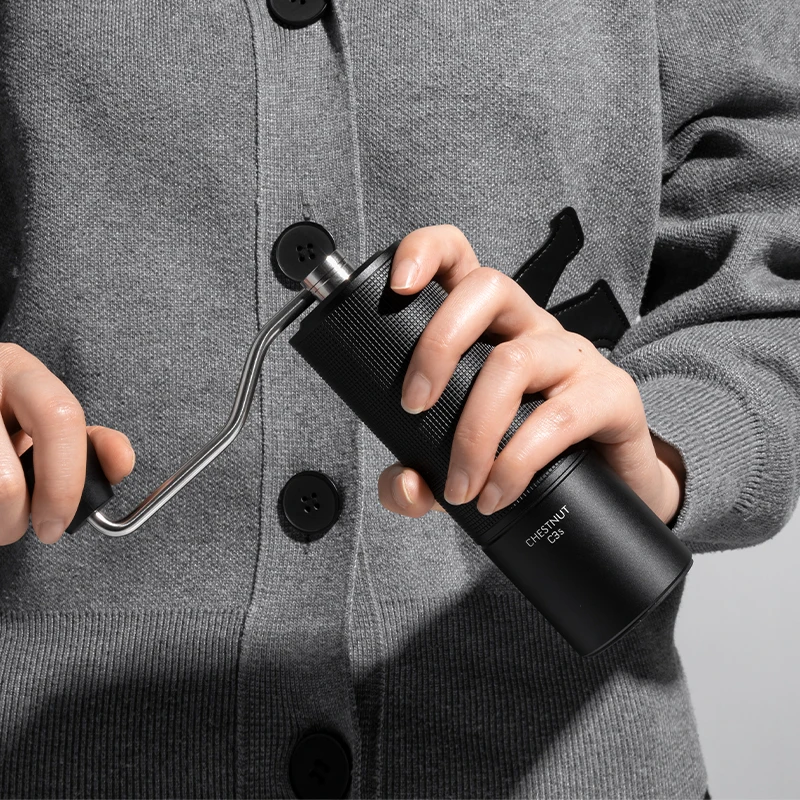
The long-term ownership experience differs substantially between blade and burr grinders, with distinct differences in durability, maintenance requirements, and typical lifespan.
Blade grinders generally have a simpler construction with fewer moving parts, which can be advantageous for basic reliability. However, their motors are typically less robust and can burn out after 1-3 years of regular use. The blades themselves eventually dull, with no practical way to sharpen or replace them in most models.
Burr grinders, particularly quality models, offer significantly longer lifespans:
– Well-made manual burr grinders can last decades
– Electric burr grinders typically last 5-10+ years with proper care
– Many have replaceable burrs, extending their useful life even further
Maintenance requirements also differ between the types:
Blade Grinder Maintenance:
– Simple cleaning by wiping out the chamber
– Limited access to areas beneath the blades
– No serviceable parts for most models
Burr Grinder Maintenance:
– Regular cleaning to remove coffee oils and residue
– Periodic deep cleaning by disassembling burr assembly
– Occasional burr replacement (typically after many years)
– More complex cleaning procedures
The comprehensive manual burr grinder maintenance guide provides detailed information on keeping your grinder in optimal condition. While burr grinders require more maintenance, this routine care preserves their performance and extends their lifespan significantly.
Comprehensive Comparison: Burr vs. Blade at a Glance
| Feature | Burr Grinder | Blade Grinder |
|---|---|---|
| Grinding mechanism | Crushing between abrasive surfaces | Chopping with spinning blades |
| Grind consistency | Highly uniform | Very inconsistent |
| Heat generation | Low (preserves flavor) | High (can alter flavor) |
| Noise level | Moderate to low (especially manual) | Typically loud |
| Price range | $40-500+ | $15-40 |
| Durability | 5-10+ years | 1-3 years |
| Maintenance needs | Moderate, regular cleaning | Low, simple cleaning |
| Grind size range | Very fine to very coarse | Limited control |
| Adjustability | Precise settings | Minimal (time-based only) |
| Suitable brewing methods | All brewing methods | Less demanding methods |
| Speed of grinding | Slower, especially manual versions | Quick operation |
| Footprint/size | Generally larger (electric models) | Compact |
This comparison highlights why coffee professionals and enthusiasts overwhelmingly prefer burr grinders. However, the choice ultimately depends on your specific needs, budget constraints, and how important coffee quality is in your daily routine.
For more detailed guidance on choosing between burr and blade grinders, consider your specific brewing methods and quality expectations.
Which Grinder Type is Right for You?
Despite the clear technical advantages of burr grinders, they aren’t necessarily the right choice for everyone. Your personal coffee habits, budget, and quality expectations should guide this decision.
A blade grinder might be sufficient if:
– You’re an occasional coffee drinker
– You primarily use brewing methods that are less sensitive to grind consistency (such as drip machines with paper filters)
– You’re on a strict budget and just beginning your coffee journey
– You need a multi-purpose grinder for spices and coffee
– You value convenience and speed over optimal flavor extraction
A burr grinder is recommended if:
– You brew coffee daily and value consistent quality
– You use brewing methods sensitive to grind size (espresso, pour-over, French press)
– You’ve invested in quality beans and want to extract their full potential
– You enjoy exploring different coffees and brewing methods
– You consider coffee quality an important part of your daily routine
For those new to specialty coffee, an entry-level burr grinder or quality manual grinder offers a tremendous quality improvement over blade grinding without requiring a substantial investment. As your palate develops, you may later choose to upgrade to a higher-end model with more precise adjustment capabilities.
Our general hand coffee grinder collection offers options suitable for various experience levels and brewing preferences.
Fine Adjustment Hand Grinder, Precision Manual Grinder, Travel Coffee Grinder
Price range: $185.11 through $494.63 Select options This product has multiple variants. The options may be chosen on the product pageHand Burr Grinder, Hand Crank Coffee Grinder, Manual Espresso Grinder, Portable Coffee Grinder
Price range: $262.72 through $300.22 Select options This product has multiple variants. The options may be chosen on the product pageManual Burr Mill, Manual Coffee Grinder Stainless Steel, Manual Coffee Mill Grinder, Mechanical Coffee Grinder
Price range: $127.26 through $130.32 Select options This product has multiple variants. The options may be chosen on the product pageHand Burr Grinder, Manual Coffee Grinder Stainless Steel, Precision Manual Grinder
Price range: $183.64 through $187.52 Select options This product has multiple variants. The options may be chosen on the product page
Are Manual Burr Grinders a Good Alternative?

Manual burr grinders represent an excellent middle-ground option that offers the precision of burrs without the higher price typically associated with electric burr grinders. These hand-powered devices have gained popularity among coffee enthusiasts for several compelling reasons.
Advantages of Manual Burr Grinders:
– Much more affordable than electric burr grinders ($25-150 for quality options)
– Often feature precision burrs comparable to more expensive electric models
– Completely portable and usable without electricity
– Typically more durable with fewer parts that can break
– Generally quieter operation
– More engaging, hands-on brewing experience
Considerations:
– Requires physical effort to operate
– Takes longer to grind (30-60 seconds for a single cup)
– May be challenging for those with hand strength or mobility issues
– Limited capacity for grinding multiple servings
The quality of manual burr grinders varies widely. Budget models under $25 often use inferior burrs that don’t offer significant advantages over blade grinders. However, models in the $40-100 range from reputable manufacturers typically provide excellent grind consistency that rivals electric grinders costing much more.
Many coffee enthusiasts discover that manual burr grinders compare favorably to electric blade models in terms of grind quality, making them an excellent upgrade path. At Savor Suite, our portable coffee grinder selection offers excellent options for both home use and travel.
Can You Use a Blade Grinder for Espresso?
Espresso presents the most demanding grinding requirements of any brewing method, requiring very fine, extremely consistent grounds to create proper resistance to pressurized water. This leads to a straightforward answer to a common question: blade grinders are not suitable for espresso preparation.
The inconsistent particle size from blade grinders creates significant problems in espresso brewing:
– Fine particles clog the filter basket and over-extract
– Larger particles allow water to channel through, under-extracting
– The resulting shot is typically both bitter and sour simultaneously
– Proper extraction time and pressure are impossible to achieve consistently
Even with workarounds like sifting grounds through fine mesh to remove larger particles, blade grinders simply cannot produce the uniform, fine grind that espresso machines require to function properly.
If you’re interested in brewing espresso at home, even an entry-level burr grinder specifically designed for espresso represents a significant—and necessary—investment. Understanding why burr grinders are essential for espresso helps explain why this is one area where compromising on equipment inevitably leads to disappointing results.
Is Grind Consistency Really That Important?
Given the significant price difference between grinder types, it’s reasonable to question whether grind consistency truly matters enough to justify the investment in a burr grinder. The answer depends on your taste perception and brewing methods, but the science is clear.
Coffee extraction is fundamentally a matter of controlled dissolution—water dissolves compounds from coffee grounds at different rates. Smaller particles extract more quickly than larger ones. When your grounds contain widely varying particle sizes, you cannot achieve balanced extraction because some particles will inevitably over-extract while others under-extract.
In blind taste tests, even casual coffee drinkers can typically identify the cup brewed with consistently ground coffee as smoother, sweeter, and more balanced. The difference becomes even more apparent with lighter roasts and single-origin coffees, where subtle flavor notes can be either highlighted or obscured by grinding quality.
That said, grind consistency matters more for some brewing methods than others. French press and espresso are particularly sensitive to grind consistency, while automatic drip machines with paper filters are somewhat more forgiving.
Ultimately, understanding whether a burr grinder truly makes a difference in your specific situation depends on your taste preferences and brewing methods. For many coffee lovers, the improvement in cup quality provides daily enjoyment that easily justifies the investment.

